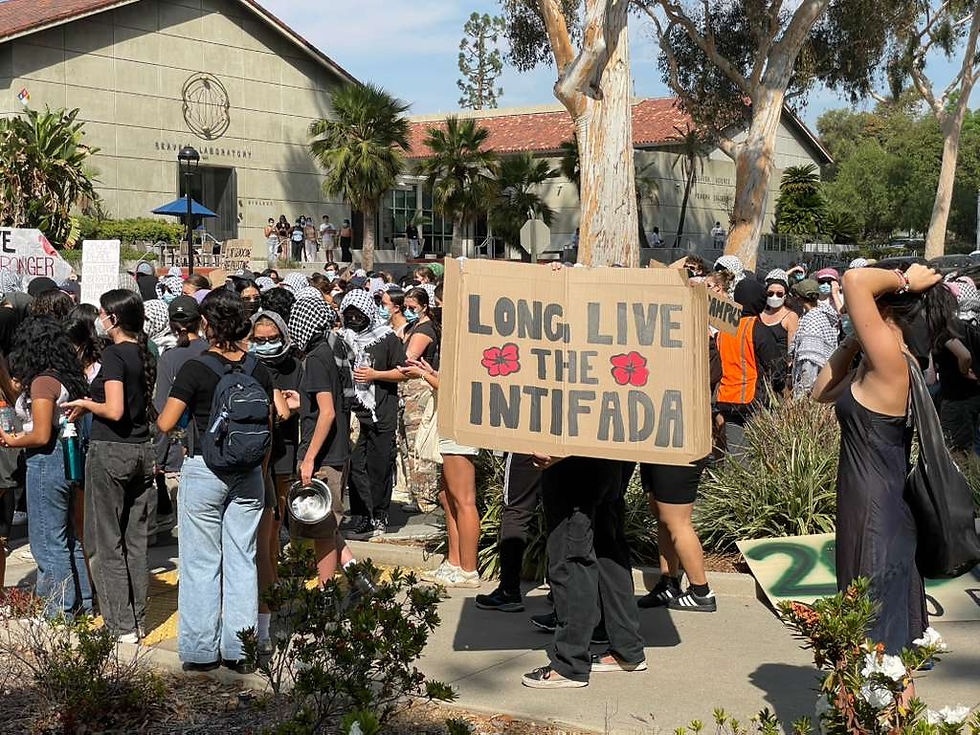Pomona Plasters Social Justice Artwork Across Campus
- The Claremont Independent

- Mar 20, 2018
- 3 min read
On March 2nd, Pomona College’s Art Museum, in collaboration with “artist activist” Alexandra Bell, mounted three large works of art throughout campus, denouncing language “perpetuat[ing] racist narratives” used by the New York Times. The artwork juxtaposes enlarged printouts of select New York Times articles with versions edited by Bell containing more “racially neutral language.” One of the works has been plastered to the wall containing the main entrance of Pomona’s Lilliore Green Rains Center for Sport and Recreation, the college’s primary athletic facility

Bell’s artwork—titled “Olympic Threat”—in front of the main athletic center’s entrance.
According to a press release from the museum, the exhibition—part of Bell’s art project, which is titled Counternarrative—“explores how language perpetuates racist narratives. She highlights the hidden language codes, picture choice, and headlines that expose editorial bias in mainstream media. Using articles from the New York Times, the paper of record presumed to be a liberal voice, Bell ‘radically reedits’ the articles. She reads, redacts, and erases [the original New York Times articles’] loaded text and images, revising the stories with racially neutral language and visual imagery that is more descriptive of the headlines she investigates.”
A flyer promoting the exhibition described Bell’s work as “investigat[ing] the language used by the New York Times to codify otherness, violence and justice in the United States.”
The press release also adds that through Counternarratives, Bell “exposes how racism is structured, codified and normalized through language and in the persistent decriminalization of whiteness.”
The three works from Counternarratives plastered on the campus’s walls are “A Teenager with Promise,” “Olympic Threat,” and “Charlottesville.”
“Olympic Threat,” plastered on the college’s main athletic center (shown in cover photo), changes a New York Times article on Ryan Lochte’s disputed claims of being robbed while partaking in the 2016 Summer Olympics in Rio de Janeiro. The printout of the original article has edits from a marker scrawled throughout the article, with comments such as “Change Title” and “he lied”—referring to Lochte, the white swimmer. Underlining part of the original article reading “…privilege, accountability and danger in a society where many Brazilians themselves often lament their exposure to alarming levels of violent crime and police corruption,” Bell adds the comment, “pretty much America.” Bell also changes the title from “Accused of Fabricating Robbery, Swimmers Fuel Tension in Brazil” to “Rio Gas Station Footage Reveals White-American Swimmers Were Offenders.”

“A Teenager with a Promise” plastered on the west wall of the Pomona College Art Museum.
The wall on the west side of the art museum hosts “A Teenager with a Promise,” a heavily edited printout of the New York Times article “Two Lives at Crossroads in Ferguson.” Bel deletes all the body content of the article, except for the lines “fatally shot an unarmed black teenager named Michael Brown” and “his shooting death by Darren Wilson, a white police officer.”
Some Pomona students voiced concerns about the placement of Bell’s art around the campus.
One Pomona sophomore and student-athlete told the Independent that “[t]aking sides on such a controversial issue as the Michael Brown shooting can turn off prospective students whose views may differ from those on display. “Furthermore, the attack on the NYT [New York Times] fails to take into account the newspaper’s prior record.”
The placement of Bell’s art on the front entrance of the main athletic center is also concerning for athletic recruitment, he adds:
“Athletic recruits tend not to be nearly as liberal in comparison to the general population of Pomona. Therefore, they might not appreciate the assumption on behalf of the college that everyone shares the same views.”
.png)



Comments